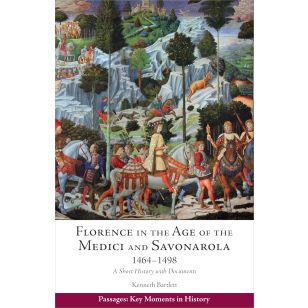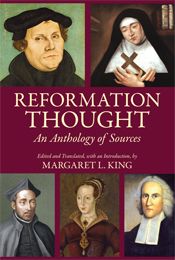Florence in the Age of the Medici and Savonarola, 1464–1498
Series: Passages: Key Moments in History
"Bartlett does an excellent job of illustrating events and issues relevant to the historical period. [His introduction] succeeds in placing the history of Renaissance Florence in a broader geographical and chronological context, not only by explaining how the rise of the Medici family was possible but also by illustrating the dynamics that linked the Republic of Florence to other Italian and non-Italian states. . . . The style is very clear, the narrative is effectively structured, and the text, while avoiding oversimplification, is easily accessible. . . . The brilliant first part [of this book] provides an enjoyable and informative introduction to the subject for English-speaking readers. . . . The sources show how Renaissance Florence's extraordinary historical players, such as Cosimo and Piero de' Medici, Lorenzo the Magnificent, and Girolamo Savonarola, were perceived by their contemporaries. The wide range of different kinds of documents, such as chronicles, letters, diaries, and sermons, is ideal for students who want to get a glimpse of what and how fifteenth-century people used to write." —Stefano Dall'aglio, in Renaissance and Reformation
"A brief narrative overview of the mainly political history of Florence to the end of the fifteenth century that also offers an attractive collection of illustrative documents, aimed to engage student interest and discussion." —Melissa Bullard, The University of North Carolina at Chapel Hill
An eBook edition is available for $15.50, click here for more information and purchasing options. Ebook examination copies are also available to qualified course instructors.
Set within the context of the struggles in the Florentine Republic over the distribution of political power and the search for stability, Florence in the Age of the Medici and Savonarola, 1464–1498: A Short History with Documents illuminates a key moment of fifteenth-century Florentine history with a focus on the monumental personalities and actions of Lorenzo de’Medici and Fra Girolamo Savonarola.
Reviews:
"Bartlett does an excellent job of illustrating events and issues relevant to the historical period. [His introduction] succeeds in placing the history of Renaissance Florence in a broader geographical and chronological context, not only by explaining how the rise of the Medici family was possible but also by illustrating the dynamics that linked the Republic of Florence to other Italian and non-Italian states. . . . The style is very clear, the narrative is effectively structured, and the text, while avoiding oversimplification, is easily accessible.
"The brilliant first part [of this book] provides an enjoyable and informative introduction to the subject for English-speaking readers. . . . The sources show how Renaissance Florence's extraordinary historical players, such as Cosimo and Piero de' Medici, Lorenzo the Magnificent, and Girolamo Savonarola, were perceived by their contemporaries. The wide range of different kinds of documents, such as chronicles, letters, diaries, and sermons, is ideal for students who want to get a glimpse of what and how fifteenth-century people used to write."
—Stefano Dall'aglio, in Renaissance and Reformation
"A brief narrative overview of the mainly political history of Florence to the end of the fifteenth century that also offers an attractive collection of illustrative documents, aimed to engage student interest and discussion."
—Melissa Bullard, The University of North Carolina at Chapel Hill
"Bartlett cuts through the political complexities of fifteenth-century Florence to offer students an engaging and accessible narrative supplemented by a wide range of relevant primary documents. This story of a key turning point in Florentine history continues to have much relevance in our own society.”
—Brian J. Maxson, East Tennessee State University
About the Author:
Kenneth Bartlett is Professor of History and of Renaissance Studies, University of Toronto.
Contents:
List of Illustrations
Preface
Chapter One: Florence before the Medici
Chapter Two: The Medici Hegemony (1434-1494)
Chapter Three: Savonarola and Florence, the New Jerusalem (1494-1498)
Afterward
Documents
- 1. Guelfs and Ghibellines, 1347
- 2. Best Practices for Florentine Merchants in the Fourteenth Century
- 3. Excerpts from Ordinances of Justice, 1293
- 4. The Arrival of Walter of Brienne from Giovanni Villani's New Chronicle
- 5. A Merchant's Conscience from the Ricordanze (Memoir) of Gregorio Dati
- 6. The Demands of the Ciompi, 1378
- 7. A Letter from Piero de’Medici Representing the Medici Bank in Bruges Regarding a Papal Appointment of a Bishop
- 8. Pius II (Aeneas Silvius Piccolomini) on Cosimo de’Medici’s Character, Wealth, and Power
- 9. Leonardo Bruni’s Praise of the City of Florence
- 10. Timoteo Maffei’s Defense of Cosimo’s Patronage
- 11. The Plot against Piero di Cosimo, 1466, Described in the Diary of Luca Landucci
- 12. A Letter from Lucrezia Tornabuoni to Her Husband, Piero, Discussing a Prospective Bride for Their Son Lorenzo
- 13. Tumult in Florence, 1470, from a Letter from Alessandra Strozzi to Her Son Filippo, in Naples
- 14. Lorenzo de'Medici, the Magnificent, on His Expenses
- 15. The Sack of Volterra as Witnessed by an Exiled Volterran Poet
- 16. Angelo Poliziano's Description of the Pazzi Conspiracy
- 18. An Allegory of Lorenzo the Magnificent and Florence by Luca Pulci
- 19. Lorenzo de'Medici Writes a Letter to His Son Giovanni on Becoming a Cardinal
- 20. Lorenzo de'Medici as a Collector and Patron: Excerpt from Lorenzo’s Ricordi (Memoirs)
- 21. The Religious Culture in Florence before Savonarola
- 22. The Expulsion of the Medici as Described by the Diarist Luca Landucci
- 23. Savonarola’s Treatise on Florentine Government
- 24. The Faith of Christ is True, Because it Causes Men to Lead a Perfect Life
- 25. An Anonymous Florentine Prophecy with Fraticelli Mystical References
- 26. Laude (Song) from Early Fourteenth-Century Laudario of a Florentine Confraternity, the Company of Santo Spirito
- 27. Savonarola, Aggeus, Sermon 13, Delivered December 14, 1494
- 28. The Bands of Hope and the Expulsion of the Jews, 1496, from the History of Piero Parenti
- 29. The Pseudo-Fra Pacifico Burlamacchi on the Burning of the Vanities, February 7, 1497
- 30. Girolamo Benivieni, "Viva nei nostri cuori, o Florentia"
- 31. Savonarola’s Sermon of February 11, 1498, Delivered in Defiance of the Ban on Preaching Issued by Pope Alexander VI in May, 1497
- 32. The Examination, Execution and Burning of Savonarola and Two Disciples as Described by Luca Landucci in His Diary
Selected Bibliography
Glossary







